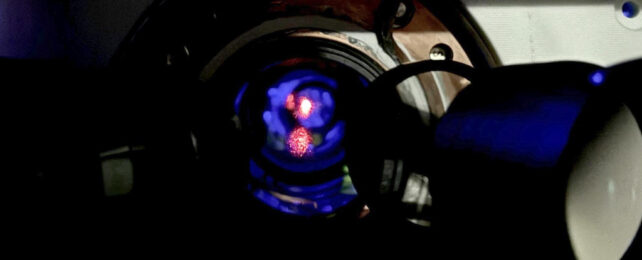Time: It bends and warps, or seems to speed up or slow down, depending on your position or perception. So measuring its passing accurately is one of the most fundamental tasks in physics – which could help land us on Mars or even observe dark matter.
Now, physicists at the US National Institute of Standards and Technology (NIST) and the University of Delaware have developed the most accurate and precise atomic clock yet, using a 'web' of light to trap and excite a diffuse cloud of cold strontium atoms.
"This clock is so precise that it can detect tiny effects predicted by theories such as general relativity, even at the microscopic scale," says Jun Ye, a physicist at the NIST's Joint Institute for Laboratory Astrophysics (JILA) lab at the University of Colorado. "It's pushing the boundaries of what's possible with timekeeping."
With a total systematic accuracy of 8.1 x 10-19, the strontium clock is twice as accurate and more precise than the previous record holder.
NIST is a place where researchers tinker with technologies to ratchet up the accuracy of global standard measurements, such as the international unit of time; the second.
Where a solid block of material can be used to represent a unit of mass, time lacks a persistent physical property we can return to for a consistent measurement. Instead, we rely on patterns that repeat in reliable ways, such as Earth's rotation, the swing of a pendulum, or the buzz of an electrified piece of quartz.
Predictable as each is, even Earth's rotation slows down and speeds up in increments. Finding patterns in nature that can be measured in ways that vary by the smallest of degrees would lead to ever more accurate measures of timekeeping.
One such pattern is the jitter of excited electrons surrounding an atom. The standard second, for example, is defined by the 'jumping' of specific electrons orbiting a cesium atom. Energized by microwaves of a particular frequency, they launch into higher energy states and back down again 9,192,631,770 times per second.
First developed in 1955 and improved ever since, today's best cesium atomic clocks keep time to within one three hundred millionths of a second per year. Your quartz wristwatch, in comparison, loses or gains about 180 seconds (or 3 minutes) each year.
Measurement scientists are, however, considering redefining the second in the next decade because atomic clock technologies are advancing rapidly.
In the past two decades, atomic clocks that excite atoms or ions with shorter wavelengths of light than microwaves have come to the fore, setting records for stability and accuracy.
This new atomic clock, developed by JILA physicist Alexander Aeppli and colleagues, is atomic leaps and bounds ahead of the previous best optical lattice clock, which Ye and other JILA colleagues helped develop in 2019.
"It sets the accuracy benchmark of all optical clocks reported to date," Aeppli, Ye, and colleagues write in their preprint, describing the new clock.
In its one-dimensional 'web' of laser light, the clock traps tens of thousands of strontium atoms, offering a higher level of precision. The shallow web of light, operating in an ultra-high vacuum on a thin layer of super-cold strontium atoms, also minimizes errors by reducing the destabilizing effects of the lasers and atoms bumping into one another.
With this precision underpinning its accuracy, the clock is expected to lose only one second every 30 billion years – which could help space travelers keep time over vast distances.
"If we want to land a spacecraft on Mars with pinpoint accuracy, we're going to need clocks that are orders of magnitude more precise than what we have today in GPS," Ye says. "This new clock is a major step towards making that possible."
Increasingly precise clocks might also register tiny deviations in the atoms' oscillations, which may signal a weak interaction with dark matter or the relativistic pull of gravity.
"Every gain in stability and accuracy opens new realms of exploration, such as placing bounds on dark matter [or] probing general relativity," the researchers write.
But there may be other ways to reach those new frontiers, aside from optical atomic clocks. Researchers have also been experimenting with using quantum entanglement to keep time, and exciting atomic nuclei, not whole atoms, with lasers, which could be used to create more stable time-keeping devices.
The research has been posted to the arXiv preprint server, ahead of its publication in Physical Review Letters, a peer-reviewed journal.
